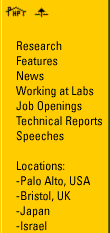HP Labs Technical Reports
Click here for full text:

Policy Based Monitoring of a Web-Based Service
Baldwin, Adrian; Casassa Mont, Marco
HPL-98-76
Keyword(s): service management; system management; policies; monitoring
Abstract: The Internet provides an infrastructure for deploying and delivering business critical services either within a corporate Intranet as out-sourced services or even end-user services such as shops selling consumer products. For such services to be successful it is essential that they have a user focused management system to ensure that the end user experiences a reliable and secure service. This paper addresses issues associated with service level monitoring and diagnosis of a potentially complex web site and a tool is described that allows for the generation of service level events as well as periodic analysis. 'Policies' are associated to the graphical service components in order to describe contexts and constraints regarding the correct functioning of that part of the service. For examples policies may describe the system configuration necessary for a particular part of a service; or may describe performance requirements; or even describe potential security violations. Policies are validated against data provided by an underlying information system within the management tool. This information system supports retrieval, and logging of system information and its association to a particular part of the service. An event notification mechanism allows the policy monitoring system to re-evaluate a particular policy when the information it depends on changes: failure to comply with a policy is detected and displayed on the service graph. In such a context, the service administrator can run a diagnosis script to find out details of the failure and the same mechanism can analyse system information, for example, performing security checks or driving performance trends. The service administrator needs to focus on the requirements and functioning of the service so that the effect on service provision of any changes or faults in the computer system are clear. A graphical representation of a service based on a hierarchical graph structure has been used so that the administrator can present their model of the service, navigate through the service and have significant events mapped onto their service model. The graph hierarchy allows the service to be successively decomposed into a number of sub-services or user interactions until a desired level of granularity has been reached. The graph structure is then used to represent the links between various parts of a service.
10 Pages
Back to Index
| 



